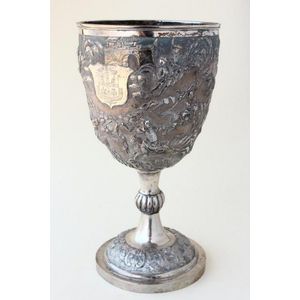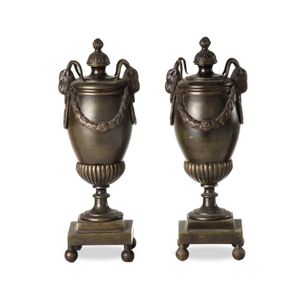French Neo Classical Bronze Urns with Marble Pedestals
You must be a subscriber, and be logged in to view price and dealer details.
Subscribe Now to view actual auction price for this item
When you subscribe, you have the option of setting the currency in which to display prices to $Au, $US, $NZ or Stg.
- Circa - A Latin term meaning 'about', often used in the antique trade to give an approximate date for the piece, usually considered to be five years on either side of the circa year. Thus, circa 1900 means the piece was made about 1900, probably between 1895 and 1905. The expression is sometimes abbreviated to c.1900.
- Neo Classical - The period or style, known as "neo-classical", was based on Greek and Roman designs and motifs, and is usually associated with the influence of the four Adam brothers, but principally Robert Adam, the second oldest of the brothers, who were architects and designers, active in the latter half ot the 18th century (1760s to 1790s).
Born in Scotland in 1728, Robert Adam spent time in Italy studying and his designs are influenced by the finds made during the excavation of Pompei.
When he returned to England he became the Court Architect to George III (1738-1820).
In turn, designs by Adam then influenced Hepplewhite.
Neo-classical ornamentation is characterised by use of classical urns, palmettes, mythical creatures such as the sphinx and griffin, ram's heads, swags, scrolling foliage, and use of the Greek key pattern. - Bronze - An alloy of copper and tin, traditionally in the proportions of about 9 parts of copper to 1 part of tin.
The discovery of bronze in Western Asia in the 4th century enabled people to create metal objects which were superior to those previoulsy possible because of its strength and hardness, and it has been used throughout the world for weapons, coins, tools, statuary and other decorative items.
It is very fluid in a molten state, and its hardness, strength when set, and non-corrosive properties makes it most suitable for casting sculpture.
This item has been included into following indexes:
Visually similar items

An impressive pair of bronze and brass urns having Bachanalian scene. 33 cm high.

Large Chinese late 19th/early 20th century silver goblet, by Wang Hing, with deep bowl, the exterior decorated with a continuous scene of figures fighting on horse back, set with armorial for Scots College, raised on knob stem and domed foot, impressed mak

A pair of Regency bronze cassolettes, in the form of urns with rams head mounts and floral garlands, surmounted by reversable laurel leaf finials, supported on gadrooned and turned columns, raised on stepped plinth bases with bun feet, 21 cm high

A pair of heavy silver trophy wine goblets, modelled after early Georgian examples, the bell bowls engraved with crest and inscription 'The Honourable Society of the Middle Temple', 'Benchers Challenge Cup'. London 1933 by H.H. Plante. Total weight 476gms.
